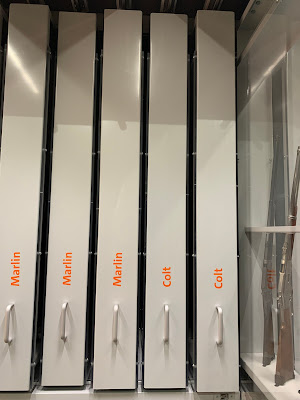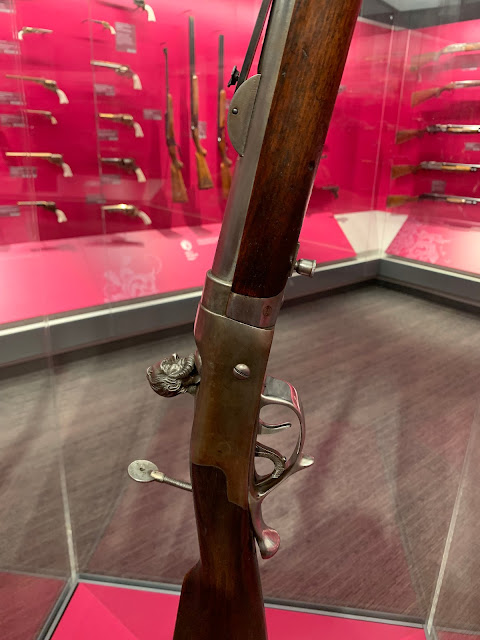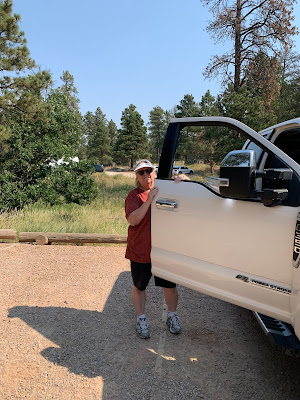After our brief visit in Eastern Wyoming, we headed west with a final destination of Cody. We made a brief stop for the night in Buffalo and the next morning we were back on the road. It was a cold morning (the truck was even cold) so we turned on the heat (heat?) and set out. We climbed the Powder River pass to a final elevation of about 9500 feet. Uh-oh!!!
After we arrived (phew!) we relaxed until the next day when we headed to the Buffalo Bill Center of the West.
We started at the Buffalo Bill Museum.
William Frederick Cody (1846-1917) was an American soldier, bison hunter, and showman. Buffalo Bill started working at the age of eleven, after his father's death, and became a rider for the Pony Express at the age of 15. During the Civil War, he served the Union from 1863 to the end of the war in 1865. Later he served as a civilian scout for the U.S. Army during the Indian Wars, receiving the Medal of Honor in 1872.
One of the most famous and well-known figures of the Old West, Buffalo Bill's legend began to spread when he was only 23. Shortly thereafter he started performing in shows that displayed cowboy themes and episodes from the frontier and Indian Wars. He founded Buffalo Bill's Wild West in 1883, taking his company on tours in the U.S. and, beginning in 1887, in Great Britain and Europe.
Buffalo Bill Cody
Oh my gosh, if you like western artifacts, especially those of Buffalo Bill, you would love this museum! Some items of interest.
Buffalo Bill's jacket and guns
Theodore Roosevelt's Saddle, c. 1885 Note the attached rear saddle pockets, the floral leather tooling, and Roosevelt's "TR" stamped on the cantle. Roosevelt owned and used this saddle on his ranch in the Dakota Badlands.
Annie Oakley was also featured.
Annie Oakley became one of the most prominent celebrities of Buffalo Bill's Wild West through her incredible target-shooting skills. Some considered shooting expertise to be a masculine art, yet Annie Oakley consistently touted her feminine charm and looks as evident in this elegant wool riding habit she wore while performing.
George B. McClellan designed the McClellan saddle for military use in the 1850s. The saddle was simple, inexpensive, and lightweight yet sturdy. Buffalo Bill likely rode in a McClellan saddle in the Seventh Kansas Volunteer Cavalry during the Civil War, and later as a scout for the United States Army. The Army continued using the McClellan saddle, with minor variations, for nearly ninety years, up to World War II.
Amelia Earhart's flight jacked which was worn on her historic flight across the Atlantic Ocean.
Sometime between 1934-1936, the aviator visited the Double D Ranch near Meeteetse, Wyoming, about 45 miles southwest of Cody. She became friends with the owner of the ranch, Carl Dunrud, and after her death, he donated the jacket to the Museum.
Phew, so much to see but we were losing steam and we wanted to check out a few of the other museums.
This place was incredible!
A few interesting items.
See Lincoln's bust?
But by far the most interesting gun was this one.
This gun probably doesn't seem like anything "special" - oh, but you are wrong. Ron's maternal grandmother was given THIS EXACT TYPE OF RIFLE by a boyfriend before her marriage. And at some point, possibly after her death, Ron's mother inherited the rifle. And then many, many years ago she gifted this rifle to Ron. And now it lives in a safe place (no, not the Gun Museum).
We were exhausted but made a short stop in the Natural History Museum and saw even more interesting things.
I guess we were too tired to take photos until we got to an art exhibit with an auction in progress. I'm not really all that interested in art but these two bronze pieces were exquisite.
Three dimensional award winner
What a day but we both decided we were "museumed out". But we still had a few more days in Wyoming. Come back to read about those days.




















































